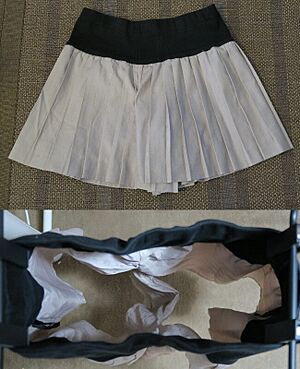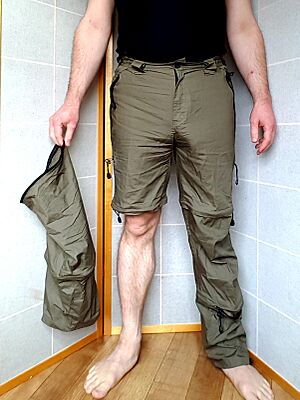Shorts facts for kids
Shorts are a type of trousers or pants that only cover part of your legs. They do not go all the way down to your ankles. Both boys and girls, and men and women, wear shorts.
People wear shorts for different reasons:
- Fashion: They can look cool and stylish.
- Comfort: They are great for warm weather because they are light and help you stay cool. They also make it easy to move, which is why they are popular for sports.
- Uniforms: Some schools, sports teams, or groups require people to wear shorts as part of their uniform.
Contents
Types of Shorts
There are many different kinds of shorts, each with its own style and purpose.
Baggies
Baggies are loose-fitting shorts that usually reach your knees. They have been popular in soccer and similar sports since 1904. Before that, players wore longer pants called knickerbockers. Over time, soccer players started wearing much shorter shorts, but then in the 1990s, longer, baggier shorts became popular again.
Bermuda Shorts
Bermuda shorts are short trousers that end about three to four inches above the knee. They are often worn in Bermuda as part of business clothes, sometimes with knee-socks and a blazer. They come in many colors. Even though they are named after Bermuda, they were first designed around 1900 for British soldiers in warm places. Tourists later helped spread the style around the world as casual wear.
In the 1990s, Bermuda shorts became a trendy option for women in France. In America, they became popular for both men and women on college campuses from the 1920s onwards. Today, women's knee-length Bermuda shorts are sometimes called "city shorts."
Boardshorts
Boardshorts are long, loose-fitting shorts made for the beach and water sports, especially surfing. They are also known as "baggies" or "jams." They first appeared in Hawaii in the 1950s. They had special features like secure pockets and fly fastenings. Early boardshorts were made of cotton, but quick-drying materials like nylon became popular. They were made knee-length to protect surfers' legs from the wax on their surfboards.
In 1970, the company Quiksilver created a very successful boardshort design. Other well-known brands include Billabong and Rip Curl. By 2010, boardshorts were worn not just at the beach but also as everyday fashion.
Boxer Shorts
Boxer shorts are soft fabric shorts with an elastic waist. They are usually worn as underwear. They were first designed for boxing participants. In 1925, Jacob Golomb, who founded the company Everlast, created them as a new option for boxers. They also became an alternative to long underwear. From the late 1950s, men's boxer shorts started to come in fun prints and patterns. In the 1980s and 1990s, women began wearing them with T-shirts for relaxing or sleeping.
Boyshorts
Boyshorts are a type of women's underwear that became popular in the 1990s. They look a bit like very short shorts. They have wide sides and sit low on the hips. This design helps prevent visible lines under clothing. Boyshorts are also increasingly worn for sports, like by tennis players or runners, as they offer more coverage than some other athletic shorts.
Bun Huggers
Bun-huggers are very short, tight athletic shorts. They are sometimes called "racing briefs." They are similar to bikini bottoms. In the past, the International Volleyball Federation used to require female volleyball players to wear them. While some say they allow for great movement, others have felt uncomfortable with how small they are. Since the mid-2000s, boyshorts (see above) are often used instead, as they provide more coverage.
Cargo Shorts
Cargo shorts are a shorter version of cargo pants. They usually reach around the knee and have many pockets sewn onto the outside of the legs. In 1980, cargo shorts were advertised as perfect for sports or fishing because their pocket flaps kept items safe. By the mid-to-late 1990s, they became very popular in men's fashion. The pockets are useful for carrying things, but they are more practical than fancy.
Culottes
Culottes were introduced in the mid-20th century. They are shorts that look like a skirt because they have a wide, flowing design that hides the leg division. They were first made for activities like horse riding and cycling. Since the mid-20th century, culottes have been used as an alternative to skirts in women's uniforms. For example, during the Vietnam War, female Red Cross workers found them more practical when working around helicopters.
Cut-offs
"Cut-offs" is a general term for any trousers where the legs have been cut off partway down. This idea has been around since the 1930s. In the 1960s and 1970s, it became popular for young people to cut the legs off their jeans and let the edges fray. You can make cut-offs at home from old jeans, or you can buy them ready-made. Very short denim cut-offs are sometimes called "Daisy Dukes."
Cycling Shorts
Cycling shorts are tight-fitting, long shorts made especially for cycling. They help reduce rubbing. While many have an elastic waist, some serious cyclists prefer "bib shorts," which have suspenders attached. These are designed to fit a cyclist leaning forward, with the back cut longer for full coverage. Since the 1980s, cycling shorts have been designed differently for men and women to fit their bodies better.
Since the 1980s, "bike shorts" have also become a fashion item. These fashion versions often do not have the special padding that real cycling shorts have.
Denim Shorts or Jorts
Denim shorts are worn by both boys and girls, and men and women. They can also be called "jorts," which is a mix of the words "jeans" and "shorts." This term is often used for knee-length, baggy styles.
However, "denim shorts" can describe many styles made from denim, including cut-offs. The word "jorts" was added to the Oxford English Dictionary in 2013.
Gym Shorts
Gym shorts is a general term for shorts made specifically for sports and exercise.
Hotpants
The term "hotpants" appeared around 1970. It describes extremely short shorts made from fancy fabrics like velvet and silk, showing they were meant for fashion, not just practical use. The term was made popular by Women's Wear Daily. While "hotpants" is now used for any very short shorts, similar styles had been worn since the 1930s. Sometimes, very short men's shorts are also called hotpants.
Lederhosen
Lederhosen are leather shorts, often worn with matching suspenders connected by a chest band. They are a traditional clothing item from Bavaria, Germany, and other parts of Central Europe.
Running Shorts
Running shorts are a type of gym shorts made for running. They are usually very light, short, and split at the side to allow for easy leg movement. They often have a built-in briefs lining. Nylon is a popular material because it is light, dries quickly, and is strong. Nylon running shorts first appeared in the 1970s and quickly became popular. An even shorter version, often worn by people in triathlons, is called a tri-short.
For trail running, shorts are usually longer and made from stronger fabric so they do not get caught or torn on branches.
School Shorts
School shorts are designed to be part of a school uniform. They are made like regular trousers, with belt loops, pockets, and a zipper, but cut to a shorts length. In the past, they were often made of wool flannel, but now they are usually made from synthetic fabrics.
Traditional grey flannel shorts became common in British school uniforms by the 1920s. They were knee-length or just above the knee. By 2004, these traditional shorts were mostly seen in private school uniforms in the UK. Similar tailored shorts are part of school uniforms in many countries, including Australia, Singapore, South Africa, and New Zealand. They are also worn by children in groups like the Cub Scouts.
Short Shorts
As their name suggests, short shorts are shorter than average. They have been around since the 1930s, when Hollywood stars wore them for photos. They were mainly worn for sports and active things like cycling. Shorts that ended high on the thigh became more popular for casual wear and sports throughout the 1940s, 1950s, and 1960s for both men and women. In the early 1970s, when short shorts were made from fashion fabrics, they became known as hotpants (see above). The terms hotpants and short shorts are now often used to mean the same thing.
Skort
A skort is a mix of a "skirt" and "shorts." It has a flap of fabric in the front that makes it look like a skirt from the front. Skorts are often worn for sports and active hobbies. When they first came out in America in the late 1950s, they were shorts with a pleated overskirt attached.
Zip-offs
Zip-offs, also called convertible shorts or pants, are long pants that have zippers at the knee. This allows you to remove the lower part of the leg and turn them into shorts. They are often suggested for hiking or walking and have been around since the 1980s. They are also good for fishermen, as long pants can easily become wading-length shorts.
Images for kids
See also
 In Spanish: Pantalón corto para niños
In Spanish: Pantalón corto para niños





























